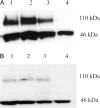The transcriptional co-activator cAMP response element-binding protein-binding protein is expressed in prostate cancer and enhances androgen- and anti-androgen-induced androgen receptor function
- PMID: 12507906
- PMCID: PMC1851122
- DOI: 10.1016/S0002-9440(10)63814-X
The transcriptional co-activator cAMP response element-binding protein-binding protein is expressed in prostate cancer and enhances androgen- and anti-androgen-induced androgen receptor function
Abstract
Progression of human prostate cancer toward therapy resistance occurs in the presence of wild-type or mutated androgen receptors (ARs) that, in some cases, exhibit aberrant activation by various steroid hormones and anti-androgens. The AR associates with a number of co-activators that possess histone acetylase activity and act as bridging molecules to components of the transcription initiation complex. In previous reports, it was shown that the transcriptional co-activator CREB (cAMP response element-binding protein)-binding protein (CBP) enhances AR activity in a ligand-dependent manner. In the present study, we have investigated whether CBP modifies antagonist/agonist balance of the nonsteroidal anti-androgens hydroxyflutamide and bicalutamide. In prostate cancer DU-145 cells, which were transiently transfected with CBP cDNA, hydroxyflutamide enhanced AR activity to a greater extent than bicalutamide in the presence of either wild-type or the mutated AR 730 val-->met. In two sublines of LNCaP cells that contain the mutated AR 877 thr-->ala and overexpressed CBP, increase in AR activity was observed after treatment with hydroxyflutamide but not with bicalutamide. Anti-androgens did not influence AR expression in cells transfected with CBP cDNA, as judged by Western blot analysis. Endogenous CBP protein was detected by Western blot in nuclear extracts from the three prostate cancer cell lines, LNCaP, PC-3, and DU-145, all derived from therapy-resistant prostate cancer. In addition, CBP was expressed in both basal and secretory cells of benign prostate epithelium, high-grade prostate intraepithelial neoplasia, and prostate cancer clinical specimens, as evidenced by immunohistochemical staining. Taken together, our findings demonstrate the selective enhancement of agonistic action of the anti-androgen hydroxyflutamide by the transcriptional co-activator CBP, which is a new, potentially relevant mechanism contributing to the acquisition of therapy resistance in prostate cancer.
Figures





References
-
- Huggins C, Hodges CV: Studies on prostatic cancer: the effects of castration, of estrogen and of androgen injection on serum phosphatases in metastatic carcinoma of the prostate. Cancer Res 1941, 1:293-297 - PubMed
-
- Labrie F, Dupont A, Belanger A, Lefebvre FA, Cusan L, Raynaud JP, Husson JM, Fazekas AT: New hormonal therapy in prostate cancer: combined use of a pure antiandrogen and an LHRH agonist. Horm Res 1983, 18:18-27 - PubMed
-
- Eisenberger MA, Blumenstein BA, Crawford ED, Miller G, McLeod DG, Loehrer PJ, Wilding G, Sears K, Culkin DJ, Thompson IMJ, Bueschen AJ, Lowe BA: Bilateral orchiectomy with or without flutamide for metastatic prostate cancer. N Engl J Med 1998, 339:1036-1042 - PubMed
-
- Blackledge GR: High-dose bicalutamide monotherapy for the treatment of prostate cancer. Urology 1996, 47:44-47 - PubMed
-
- Culig Z, Hobisch A, Cronauer MV, Cato ACB, Hittmair A, Radmayr C, Eberle J, Bartsch G, Klocker H: Mutant androgen receptor detected in an advanced stage of prostatic carcinoma is activated by adrenal androgens and progesterone. Mol Endocrinol 1993, 7:1541-1550 - PubMed
Publication types
MeSH terms
Substances
LinkOut - more resources
Full Text Sources
Medical
Research Materials
Miscellaneous

